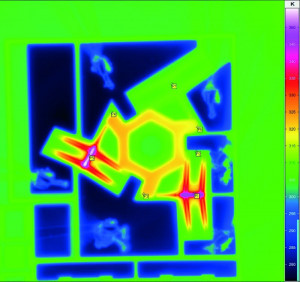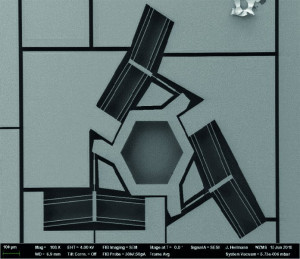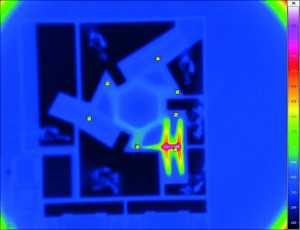Microelectromechanical systems (MEMS) offer a wide range of potential applications in the field of nanotechnology. The position detection of cell phones or the use in airbags, digital cameras or pacemakers are everyday examples. Other applications can be found primarily in the field of miniaturized medical diagnostics. A research team at Chemnitz University of Technology is working on such MEMS drives using thermography. This enables insights and optimization of thermal microdrives.
 Fig. 1: Thermographic image of a MEMS-controlled actuator with three degrees of freedom and thermal drivesMicroelectromechanicalsystems (MEMS) offer a wide range of possible applications in the field of nanotechnology. The position recognition of cell phones or the use in airbags, digital cameras or pacemakers are everyday examples. Further applications can be found especially in the field of miniaturized medical diagnostics. At the TU Chemnitz, a research team is working on such MEMS drives using thermography. This enables insights and optimizations in thermal microdrives.
Fig. 1: Thermographic image of a MEMS-controlled actuator with three degrees of freedom and thermal drivesMicroelectromechanicalsystems (MEMS) offer a wide range of possible applications in the field of nanotechnology. The position recognition of cell phones or the use in airbags, digital cameras or pacemakers are everyday examples. Further applications can be found especially in the field of miniaturized medical diagnostics. At the TU Chemnitz, a research team is working on such MEMS drives using thermography. This enables insights and optimizations in thermal microdrives.
Micromechanics is seen as a pillar of future nanotechnology applications. Growing demands for miniaturization affect both the system solutions required and the sensors and control elements to be developed. The Chair of Microsystems and Medical Technology at Chemnitz University of Technology is working on microdrives based on MEMS, which are intended to serve as a control platform for investigations on nanocomponents and are only a few micrometers in size.
Thermal microdrives for nanotechnologies
Similar to conventional electromechanical positioning tables with three degrees of freedom, micromechanical systems are designed to enable highly precise horizontal and vertical movement of components. The professorship has more than 20 years of experience in the field of electrostatic actuators.
Fig. 2: Comparison of a microscopic image with a high-resolution thermographic image taken with an ImageIR 9300 and an 8Å~ microscope lens
 Fig. 3: Detailed image of one of the MEMS drive elements used (relative temperature values)However, these electrostatic drives are unsuitable for the control elements presented here, as the corresponding investigations of MEMS are carried out on electron microscopes, whose fields would have an interfering effect. Thermal drives are therefore used as an alternative, in which the heating resulting from electrical power is converted into movement.
Fig. 3: Detailed image of one of the MEMS drive elements used (relative temperature values)However, these electrostatic drives are unsuitable for the control elements presented here, as the corresponding investigations of MEMS are carried out on electron microscopes, whose fields would have an interfering effect. Thermal drives are therefore used as an alternative, in which the heating resulting from electrical power is converted into movement.
Prototypes have already been developed at Chemnitz University of Technology that enable movements with an accuracy of up to 2 μm and 0.3°. If such precision is to be achieved, the material parameters of the actuators used must be analyzed precisely. And in the case of thermal actuators, the most important factor is measuring the component temperature as accurately as possible. The Infratec ImageIR 9300 system is used for this purpose, which enables the required thermographic resolution and evaluation when examining the miniaturized actuators.
Due to the very small dimensions and mechanical characteristics of these unusual measurement objects, the demands on the thermographic camera used are extremely high. Because the components are only a few micrometers in size, infrared microscope optics with the highest possible magnification are required. The large infrared detector of the ImageIR 9300 with (1280 Å~ 1024) IR pixels also makes it possible to capture the peripheral components around the actuators.
Diffraction-limited resolution
The system with an 8.0Å~ microscope objective is used at Chemnitz University of Technology. With the spectral range of 1.5 to 5.5 μm used, the physical limit of resolution has been reached here. Thanks to experimental emissivity determinations of individual test materials, the measured values obtained make it possible to determine heat dissipation coefficients and other material parameters. The evaluation is carried out with the thermography software Irbis 3 professional. In addition, a lock-in thermography test station with the InfraTec software Irbis active is used for real-time active thermography. As measurements are taken on silicon and aluminum, the emissivity coefficients here are very low and require careful application of special correction models.
Results
The results presented illustrate the thermal processes within the MEMS structures very clearly. Nevertheless, details remain to be clarified:
- Working on redesigning the actuators to reduce thermal crosstalk between components.
- The search for a measurement method for holistic motion detection based on automated image evaluation of the thermographic images.
Another focus is the attempt to quantify the thermoelastic damping in the MEMS springs at excitation frequencies of up to approx. 10 kHz. These investigations also require the high-precision trigger interface of the thermography system used in order to be able to follow quickly and precisely with the aid of active thermography.
 Fig. 4: Temperature profile for Figure 3 with relative temperature values
Fig. 4: Temperature profile for Figure 3 with relative temperature values
At this point, the ability of lock-in thermography to display the smallest temperature differences will become increasingly important. Particularly in the field of miniaturized medical diagnostics and analytics, future applications will make even greater use of nanotechnology components. Through the investigations presented and the use of thermography, researchers at the TU are gaining insights into the behavior of the MEMS components required for this in order to make significant progress in their development.




